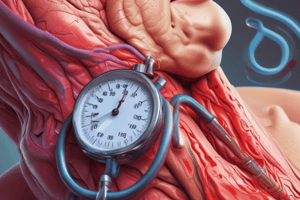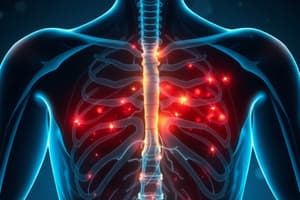Podcast
Questions and Answers
What is the purpose of constructing a meaningful stem in a question?
What is the purpose of constructing a meaningful stem in a question?
- To provide a definite problem without irrelevant material (correct)
- To make the question longer
- To distract students from the answer
- To include as many options as possible
Why should distractors in a multiple-choice question be plausible?
Why should distractors in a multiple-choice question be plausible?
- To represent common misconceptions and challenge student understanding (correct)
- To ensure that students can guess the answer correctly
- To confuse students completely
- To enhance the difficulty of finding the correct answer
What should be avoided when formulating answer options?
What should be avoided when formulating answer options?
- Using varied phrasing for each option
- Including clear and concise statements
- Referencing similar content form through distractors
- Using phrases like 'all of the above' or 'none of the above' (correct)
What is a key characteristic of the correct answer to a multiple-choice question?
What is a key characteristic of the correct answer to a multiple-choice question?
What is the advantage of using a consistent case in questions?
What is the advantage of using a consistent case in questions?
What condition is associated with low calcium levels due to decreased 1-alpha-hydroxylation of vitamin D?
What condition is associated with low calcium levels due to decreased 1-alpha-hydroxylation of vitamin D?
Which mineral imbalance is a consequence of renal failure and can lead to hypocalcemia?
Which mineral imbalance is a consequence of renal failure and can lead to hypocalcemia?
What is a potential complication that can arise in shrunken end-stage kidneys during dialysis?
What is a potential complication that can arise in shrunken end-stage kidneys during dialysis?
Which of the following describes a bone condition stemming from secondary hyperparathyroidism associated with renal failure?
Which of the following describes a bone condition stemming from secondary hyperparathyroidism associated with renal failure?
What are the main treatment options for renal failure?
What are the main treatment options for renal failure?
What is the primary cause of urinary tract infections in females?
What is the primary cause of urinary tract infections in females?
Which of the following symptoms is typical in cystitis?
Which of the following symptoms is typical in cystitis?
What is considered the gold standard for diagnosing a urinary tract infection?
What is considered the gold standard for diagnosing a urinary tract infection?
Which organism is the most common cause of urinary tract infections?
Which organism is the most common cause of urinary tract infections?
Which factor is not typically considered a risk factor for urinary tract infections?
Which factor is not typically considered a risk factor for urinary tract infections?
What does sterile pyuria indicate in a patient?
What does sterile pyuria indicate in a patient?
What is a common cause of chronic pyelonephritis in children?
What is a common cause of chronic pyelonephritis in children?
Which of the following symptoms is indicative of pyelonephritis?
Which of the following symptoms is indicative of pyelonephritis?
Which pathogen is most commonly associated with pyelonephritis?
Which pathogen is most commonly associated with pyelonephritis?
What is the primary symptom of nephrolithiasis?
What is the primary symptom of nephrolithiasis?
What can result from chronic renal failure?
What can result from chronic renal failure?
Which condition is characterized by interstitial fibrosis due to repeated infections?
Which condition is characterized by interstitial fibrosis due to repeated infections?
In chronic renal failure, which of the following is a common metabolic disturbance?
In chronic renal failure, which of the following is a common metabolic disturbance?
Flashcards
Hypocalcemia in Renal Failure
Hypocalcemia in Renal Failure
Low blood calcium levels caused by the kidney's inability to activate vitamin D, and high phosphate levels.
Renal Osteodystrophy
Renal Osteodystrophy
Bone disease in kidney failure due to overactive parathyroid glands, weak bones, and porous bones.
Dialysis
Dialysis
Treatment that uses a machine to filter the blood when the kidneys fail.
Renal Transplant
Renal Transplant
Signup and view all the flashcards
Cysts in Dialysis Patients
Cysts in Dialysis Patients
Signup and view all the flashcards
Urinary Tract Infection (UTI)
Urinary Tract Infection (UTI)
Signup and view all the flashcards
Cystitis
Cystitis
Signup and view all the flashcards
E. coli
E. coli
Signup and view all the flashcards
Urine Culture
Urine Culture
Signup and view all the flashcards
String
String
Signup and view all the flashcards
Boolean
Boolean
Signup and view all the flashcards
Null
Null
Signup and view all the flashcards
Array
Array
Signup and view all the flashcards
Object
Object
Signup and view all the flashcards
Pyelonephritis
Pyelonephritis
Signup and view all the flashcards
Chronic Pyelonephritis
Chronic Pyelonephritis
Signup and view all the flashcards
Pyuria
Pyuria
Signup and view all the flashcards
Nephrolithiasis (Kidney Stones)
Nephrolithiasis (Kidney Stones)
Signup and view all the flashcards
Chronic Renal Failure
Chronic Renal Failure
Signup and view all the flashcards
Uremia
Uremia
Signup and view all the flashcards
Enterococcus faecalis
Enterococcus faecalis
Signup and view all the flashcards
Study Notes
Hypocalcemia
- Hypocalcemia results from decreased 1-alpha-hydroxylation of vitamin D by proximal renal tubule cells and hyperphosphatemia.
Renal Osteodystrophy
- Renal osteodystrophy is due to secondary hyperparathyroidism, osteomalacia, and osteoporosis.
Treatment
- Treatment involves dialysis or renal transplant.
- Cysts often develop in shrunken end-stage kidneys during dialysis, increasing the risk for renal cell carcinoma.
Studying That Suits You
Use AI to generate personalized quizzes and flashcards to suit your learning preferences.





